
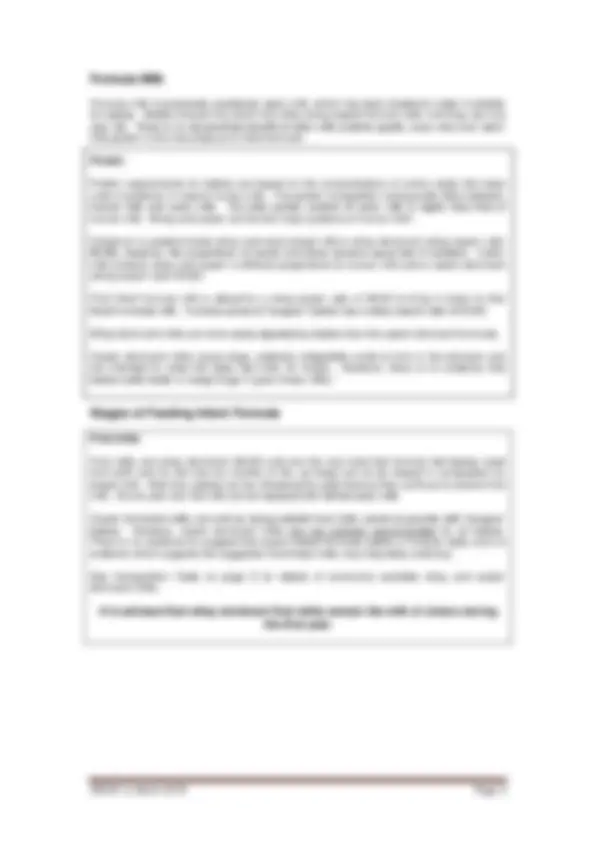
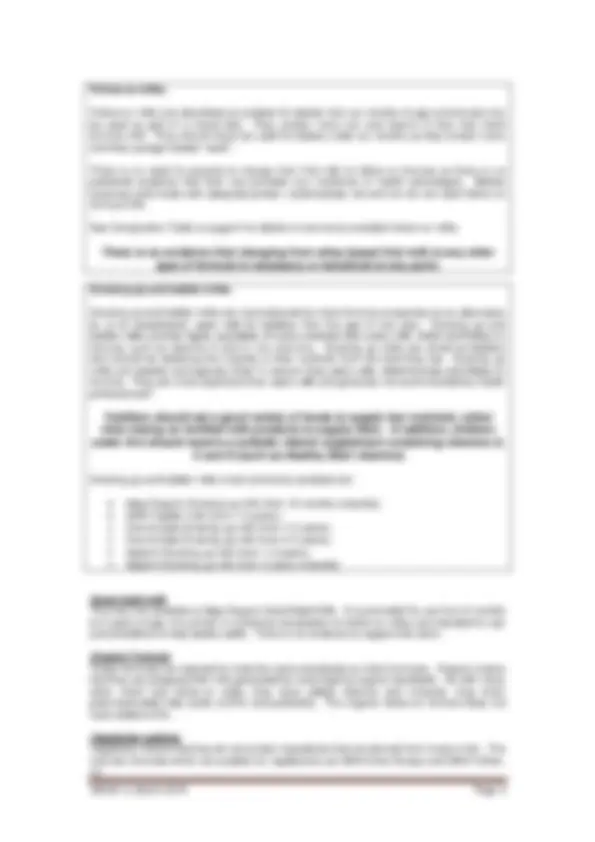
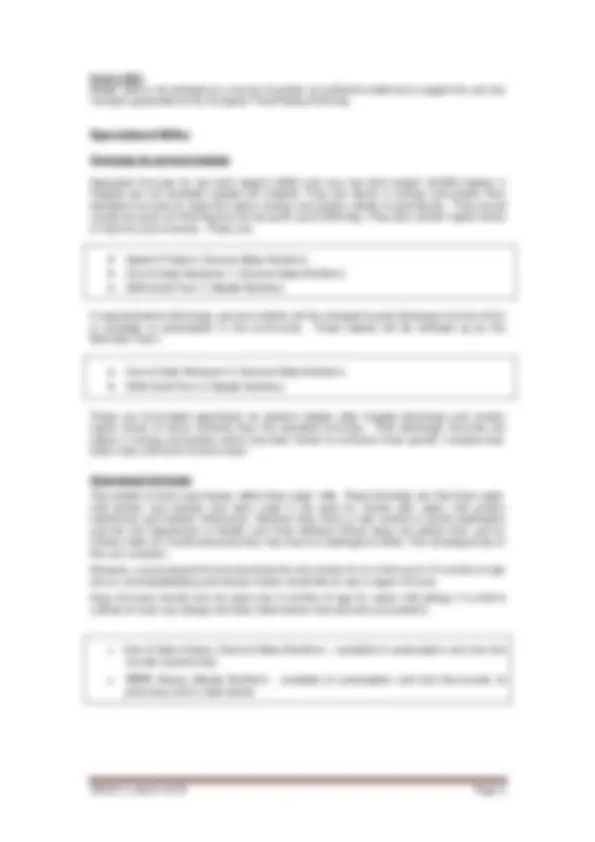
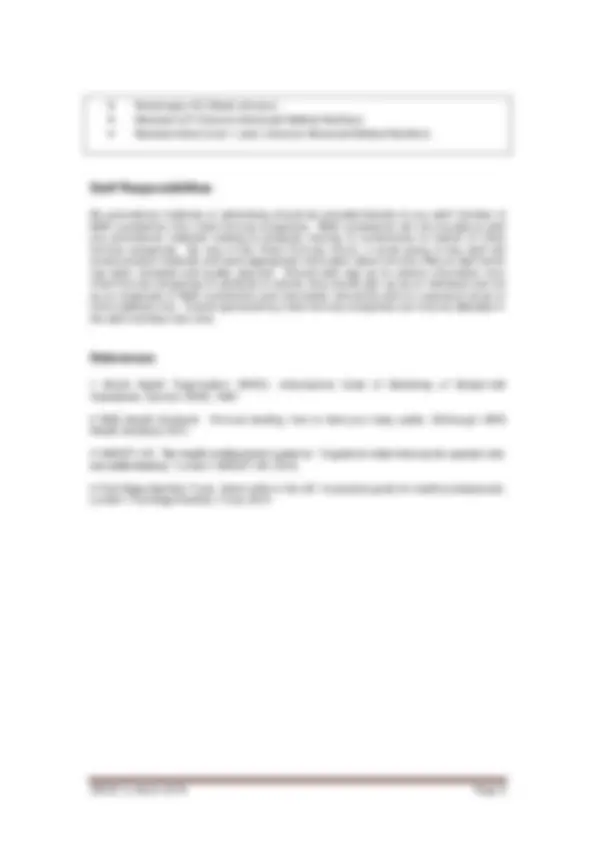

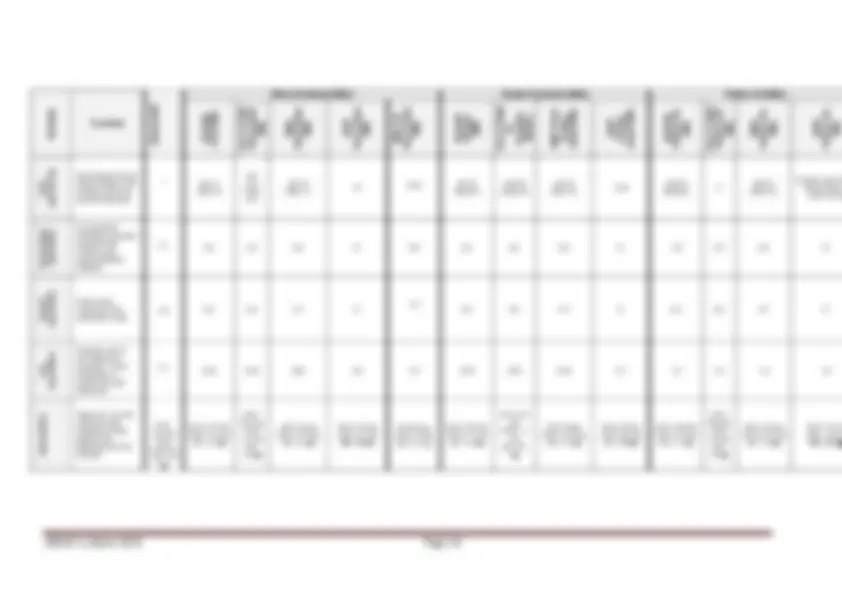


Study with the several resources on Docsity

Earn points by helping other students or get them with a premium plan


Prepare for your exams
Study with the several resources on Docsity

Earn points to download
Earn points by helping other students or get them with a premium plan
Community
Ask the community for help and clear up your study doubts
Discover the best universities in your country according to Docsity users
Free resources
Download our free guides on studying techniques, anxiety management strategies, and thesis advice from Docsity tutors
NHS Lanarkshire's duty to comply with the WHO International Code on Marketing of Breast Milk Substitutes and provides information on the range, composition, benefits, and preparation of various types of infant formula milks. It emphasizes the importance of breastfeeding and the health benefits of breast milk for infants.
What you will learn
Typology: Exams
1 / 12

This page cannot be seen from the preview
Don't miss anything!







Getting feeding right for babies and children is at the very heart of a healthy start in life.
This leaflet seeks to provide staff with up-to-date and accurate information on infant formula milks to provide to parents who have made an informed choice to formula feed their baby.
NHS Lanarkshire has a duty to comply with the WHO International Code on Marketing of Breast Milk Substitutes in order to promote and protect breastfeeding and ensure the safe and appropriate use of breast milk substitutes.
The aim of this code is to contribute to the provision of safe and adequate nutrition for infants, by the protection and promotion of breastfeeding, and by ensuring the proper use of breastmilk substitutes, when these are necessary, on the basis of adequate information and through appropriate marketing and distribution^1_._
The Code applies to the marketing, and practices related thereto, of the following products: breastmilk substitutes, including infant formula; other milk products, food and beverages, including bottle-fed complementary foods, when marketed or otherwise represented to be suitable, with or without modification, for use as a partial or total replacement of breast milk; feeding bottles and teats. It also applies to their quality and availability, and information concerning their use^1_._
This forum meets with Infant Formula company representatives to gather up-to-date and accurate information on infant formula milks for dissemination to midwives, neonatologists, public health nurses, pharmacists, GP’s and other relevant staff. Meetings will take place on a six-monthly basis and an information briefing disseminated to all relevant staff shortly after each forum meeting.
Each Infant Formula company representative will be offered a 30 minute slot to present information about their products. This presentation will include: a summary of the range of milks offered at each stage of the child’s development; the composition and benefits of each product presented; and details of any product changes since the last contact. Presentations may include information about other products, such as bottles and teats. Representatives will also be invited to provide additional written information about the products being presented.
Representatives will be invited from the main Infant Formula Milk companies.
All women should be supported to make an informed decision about their infant feeding choice. The short and long term health benefits of breast milk and breastfeeding are substantial, therefore breastfeeding should be promoted as the optimal feeding choice to ensure more mothers and children living in Lanarkshire experience the full benefits.
Breastfeeding is an individual decision for each woman. Where women decide to breastfeed they should be given support and advice to initiate and sustain exclusive breastfeeding for at least 6 months with continued breastfeeding along with appropriate complementary foods up to two years of age or beyond as recommended by WHO^1.
Some women may make an informed choice to partially breastfeed and they should be supported and given advice on how to do this whilst maintaining their lactation.
The Scottish Government and the Food Standards Agency Scotland state that it is best practice to make up infant feeds by reconstituting formula powder using water at a temperature of 70 degrees celsius or above. This aims to ensure that the potential microbiological risks associated with these products are kept to a minimum. Using water at this temperature will kill harmful pathogens if they are present in non-sterile powdered formula as well as helping reduce the risk of contamination which may occur in the home due to poor hygiene practices or feeding equipment which has not been sterilised adequately.
The three recommendations for making up a formula feed safely are:
This guidance applies to all standard infant formula and follow-on formula milks, including those containing probiotics. Specialised milks are not covered by this guidance and there are specific guidelines for preparation of these formulas; therefore they should be made up according to the instructions on the back of the pack.
All clients who have made an informed choice to formula feed should be supplied with the above booklet, which is the newest guidance on how to safely make up infant formula feeds. Mothers who have chosen to formula feed their baby in hospital will be supplied with the booklet and offered a demonstration on how to make up a formula feed safely. Women at home who change to partial breastfeeding or complete formula feeding should be given this booklet by their Community Midwife or Public Health Nurse and also offered a demonstration on how to make up a formula feed. Copies are available to order from the Health Improvement Library or available within the maternity unit in Wishaw General Hospital.
Follow-on milks
Follow-on milks are described as suitable for babies from six months of age and should only be used as part of a mixed diet. They contain more iron and vitamin D than first infant formula milk. They should never be used for babies under six months as they contain more iron than younger babies’ need^3.
There is no need for parents to change from first milk to follow-on formula as there is no published evidence that their use provides any nutritional or health advantages. Babies receiving solid foods with adequate protein, carbohydrate, fat and iron do not need follow-on formula milk.
See Composition Table on page 9 for details of commonly available follow-on milks.
Growing up and toddler milks
Growing up and toddler milks are manufactured by infant formula companies as an alternative to, or to complement, cow’s milk for toddlers from the age of one year. Growing up and toddler milks provide higher quantities of some nutrients than cow’s milk, infant and follow-on formula, such as vitamins A and D, iron and zinc. Growing up milks are aimed at toddlers who should be obtaining the majority of their nutrients from the food they eat. Growing up milks are sweeter and typically lower in calcium than cow’s milk, infant formula and follow-on formula. They are more expensive than cow’s milk and generally not recommended by health professionals^4.
Growing up and toddler milks most commonly available are:
Hipp Organic Growing up milk (from 12 months onwards); SMA Toddler milk (from 1-3 years); Cow & Gate Growing up milk (from 1-2 years); Cow & Gate Growing up milk (from 2-3 years); Aptamil Growing up milk (from 1-2 years); Aptamil Growing up milk (from 2 years onwards)
Good night milk The only one available is Hipp Organic Good Night Milk. It is promoted for use from 6 months to 3 years of age. It is similar in nutritional composition to follow on milks, but intended for use just at bedtime to help babies settle. There is no evidence to support this claim.
Organic Formula These formulas are required to meet the same standards as infant formulas. Organic means that they are prepared with milk generated by cows kept by organic standards. As with many other infant and follow-on milks, they have added vitamins and minerals, long chain polyunsaturated fatty acids (LCPs) and prebiotics. The organic follow-on formula does not have added LCPs.
Vegetarian options Vegetarian means that they do not contain ingredients that are derived from meat or fish. The only two formulas which are suitable for vegetarians are SMA Extra Hungry and SMA Follow- on.
Goat’s Milk Goats’ milk is not advised as a source of protein as sufficient evidence to support its use has not been presented to the European Food Safety Authority.
Formulas for pre-term babies
Specialist formulas for low birth weight (LBW) and very low birth weight (VLBW) babies in hospital are not available outside the hospital. They are higher in energy and protein than standard formulas to meet the higher energy and protein needs of prematurity. They would usually be given at 150ml/kg but can be given up to 200ml/kg. They also contain higher levels of vitamins and minerals. These are:
Aptamil Preterm (Danone Baby Nutrition) Cow & Gate Nutriprem 1 (Danone Baby Nutrition) SMA Gold Prem 1 (Nestle Nutrition)
If required before discharge, pre-term babies will be changed to post discharge formula which is available on prescription in the community. These babies will be followed up by the Neonatal Team:
Cow & Gate Nutriprem 2 (Danone Baby Nutrition) SMA Gold Prem 2 (Nestle Nutrition)
These are formulated specifically for preterm babies after hospital discharge and contain higher levels of some nutrients than the standard formulas. Post discharge formulas are higher in energy and protein which has been shown to enhance linear growth, increase lean body mass and bone mineral mass^4.
Soya-based formulas
The protein is from soya beans rather than cows’ milk. These formulas are free from cows’ milk protein and lactose and were used in the past for infants with cow’s milk protein intolerance and lactose intolerance. However they have a high content of phyto-oestrogens and the UK Department of Health and Chief Medical Officer does not advise their use for infants under six months because they may have an oestrogenic effect. The consequences of this are uncertain.
However, a soya-based formula would be the only choice for an infant up to 12 months of age who is not breastfeeding and whose mother would like to use a vegan formula.
Soya formulas should only be used over 6 months of age for cow’s milk allergy if a child is unlikely to have soy allergy and other alternatives have proved unsuccessful.
Cow & Gate Infasoy (Danone Baby Nutrition) – available on prescription and over-the counter at pharmacy
pharmacy and in retail stores
Lactose-free formulas
These are based on modified cows’ milk but the lactose has been replaced with glucose. These formulas are used for infants with temporary lactose intolerance following a gastro- intestinal infection or for infants with clinically diagnosed primary lactose intolerance. They
are:
Brand Manufacturer Availability
Enfamil O-Lac Mead Johnson Available on prescription only
SMA LF Nestle Nutrition Available on prescription and over-the-counter at pharmacy
Aptamil Lactose Free Danone Baby Nutrition Over-the-counter and exclusive to Boots. Not prescribable.
Breastfeeding with Cows’ Milk Allergy
If a baby has been diagnosed as having a cows' milk allergy (and has on-going allergic symptoms whilst being breastfed) it will be advised to exclude cows' milk from the mother’s diet. This should only be done after discussion with a Registered Dietitian, as it is important that breastfeeding mums eat a healthy balanced diet.
Suitable Milks for Children with Cows’ Milk Allergy
If an infant is diagnosed with cow’s milk protein allergy and is not breastfed, then one of the following products may be given. These products are available on prescription only and provide appropriate nutrition for infants with cow’s milk protein allergy.
Extensively Hydrolysed Formulas
It is the protein in cows’ milk that can cause an allergic reaction, but breaking down (hydrolysing) the whole protein into smaller segments lowers the likelihood of it causing an allergic reaction. Extensively hydrolysed formulas contain proteins that have been broken down into smaller segments so they are less likely to cause an allergic reaction.
Extensively hydrolysed casein formulas Nutramigen 1 (Mead Johnson) Nutramigen 2 (over 6 months) (Mead Johnson)
Some of these may contain prebiotics and lactose, which improve the taste.
Extensively hydrolysed whey formulas Aptamil Pepti 1 (Danone Baby Nutrition) Aptamil Pepti 2 (for 6 months and over) (Danone Baby Nutrition) Cow & Gate Pepti-junior (Danone Baby Nutrition) Althera (from birth) (Nestle Health Science) Similac Alimentum (Abbott Nutrition)
Amino Acid Formulas
These formulas are based on the individual building blocks (amino acids) that make up a protein and are highly unlikely to cause an allergic reaction. These formulas are recommended when an extensively hydrolysed formula has not been tolerated or if an
Nutramigen AA (Mead Johnson) Neocate LCP (Danone Advanced Medical Nutrition) Neocate Active (over 1 year) (Danone Advanced Medical Nutrition)
No promotional materials or advertising should be provided directly to any staff member of NHS Lanarkshire from infant formula companies. NHS Lanarkshire will not circulate to staff any promotional materials relating to products, training or conferences on behalf of infant formula companies. By way of the Infant Formula Forum, a small group of key staff will review product materials and send appropriate information about formula milks to staff which has been reviewed and quality assured. Should staff sign-up to receive information from infant formula companies on products or events, they should sign up as an individual and not as an employee of NHS Lanarkshire and information should be sent to a personal email or home address only. Events sponsored by infant formula companies can only be attended in the staff members own time.
1 World Health Organization (WHO). International Code of Marketing of Breast-milk Substitutes. Geneva: WHO, 1981.
2 NHS Health Scotland. Formula feeding: how to feed your baby safely. Edinburgh: NHS Health Scotland, 2011.
3 UNICEF UK. The health professional’s guide to: “A guide to infant formula for parents who are bottle feeding”. London: UNICEF UK, 2010.
4 First Steps Nutrition Trust. Infant milks in the UK: A practical guide for health professionals. London: First Steps Nutrition Trust, 2012.
Nutrient
Function
Breastmilk
3
Whey Dominant Milks Casein Dominant Milks Follow On Milks
Aptamil First Milk Cow & Gate^ First Infant
Milk SMA First Infant
Milk HiPP First Infant
Milk SMA HA First Infant
Milk Aptamil^ Hungry
Milk Cow & Gate
for Hungrier^ Babies SMA Extra^ Hungry Infant Milk
HiPP Hungry Infant Milk^ Aptamil Follow On
Milk Cow & Gate^ Follow On
Milk SMA Follow On
Milk HiPP Follow On
Milk
LCPs (mg
/100 ml)
AA (Omega 6) and DHA (Omega 3) for healthy brain and eye development
(^) AA 11 DHA 10
AA
DHA
AA 12 DHA 7.1 21
15.6 AA 10 DHA 9.
AA 5. DHA 5.
AA 12 DHA 7.0 13.^
AA 8. DHA 8.6 0
AA 5. DHA 3.
Linoleic acid: 0 Alpha-linolen acid: 0.07 g
Nucleotides^ (mg/100ml)
(^) An important metabolic regulator. Supports the immune and gastrointestinal systems
3 - (^7) 3.2 3.2 2.6 0* 2.0 3.2 3 .2 3 .0 0* 3.2 3.2 2.6 0*
Taurine (mg/100ml)
Amino acid involved in the absorption of fat
3.8 5.3^ 5.3^ 4.7^0 *^
3.7 (^) 5.3 5.3 4.7 0 * 5. 2 5.3 4.7 0 *
Iron (mg/100ml)
(^) Reduces risk of iron deficiency anaemia. Iron in breastmilk is particularly well absorbed
0.7 (^) 0.53 0.53 0.64 0.5 0.7 0.53 0.53 0.64 0.7 1 .0 1 .0 1.2 1.
Antioxidants
(^) Vitamins C, E and selenium help protect the body against cell damage from free radicals
Vit C: 4.0 mg Vit E: 0.34 mg Sel: 1. μg
Vit C: 9.2 mg Vit E: 1.1 mg Sel: 1.5 μg
Vit C: 9.2 mg Vit E: 1.1 mg Sel: 1.5 μg
Vit C: 9 mg Vit E: 0.7 4 mg Sel: 1.4 μg
Vit C: 10 mg Vit E: 0.7 mg Sel: 1.5 μg
Vit C:9 mg Vit E: 1.3mg Sel: 2.1 μg
Vit C: 8.3 mg Vit E: 1.1 mg Sel: 1.5 μg
Vit C: 8. mg Vit E: 1. mg Sel: 1. μg
Vit C: 9 mg Vit E: 0.7 4 mg Sel: 1.4 μg
Vit C: 10 mg Vit E: 0.8 mg Sel: 1.5 μg
Vit C: 9. 9 mg Vit E: 1.2 mg Sel: 1. 7 μg
Vit C: 9.5 mg Vit E: 1.2 mg Sel: 1.6 μg
Vit C: 12 mg Vit E: 0.7 4 mg Sel: 1.4 μg
Vit C: 10 mg Vit E: 1.0 m Sel: 1.5 μg
Nutrient
Function
Breastmilk
3
Whey Dominant Milks Casein Dominant Milks Follow On Milks
Aptamil First Milk Cow & Gate^ First Infant
Milk SMA First Infant
Milk HiPP First Infant
Milk SMA HA First Infant
Milk Aptamil^ Hungry
Milk Cow & Gate
for Hungrier^ Babies SMA Extra^ Hungry Infant Milk
HiPP Hungry Infant Milk^ Aptamil Follow On
Milk Cow & Gate^ Follow On
Milk SMA Follow On
Milk HiPP Follow On
Milk
Vitamins and minerals
Essential for healthy growth and development. Vitamins and minerals in breast milk are absorbed more efficiently than those in formula milks.
^ ^ ^ ^ ^ ^ ^ ^ ^ ^ ^
Special dietary^ requirements
Suitable for vegetarians (V) or halal approved
Halal (liquid 1 litre not Halal approved)
Halal (liquid 1 litre not Halal approv ed)
Halal
Halal
Halal (liquid 1 litre not Halal approved)
Halal (liquid 1 litre not Halal approved)
Halal (liquid 1 litre not Halal approved) Powder is vegetarian
Halal (liquid 1 litre not Halal approved)
Halal (liquid 1 litre not Halal approv ed))
Halal. Powder is vegetarian
** FOS: Fructo-oligosaccharides; GOS: Galacto-oligosaccharides